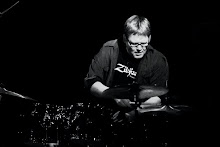I had another chance recently to hear a couple of young (high school age) drummers playing with bands in a school setting. They both played very well, but some aspects of their playing reminded me of some things I did ( and still do sometimes) in my playing that weren't very effective and were coming from a place of ego rather than serving the music I was playing.
I was very concerned with sounding hip.
Now, "hipness" is a very relative thing but as young player I thought "hip" drummers....
- never play hi-hat on 2 and 4.
-never play the ride rhythm the same way twice.
- tune their drums very high.
- listened to the popular jazz drummers of the day; in my case, DeJohnette, Jeff Watts, etc.
- had the drums constantly shifting textures. Repeating anything or playing a pattern was never hip.
So how come when I listened to recordings of myself I sounded like crap?
Well, lets look at some of my assumptions about "hip" drumming.
Static or repeating limb patterns (h.h. on 2 and 4, the basic ride pattern, and even the dreaded 4 on the bass drum) can be a great way of creating order and structure to time playing.
Just because a drummer plays h.h. on 2 and 4 throughout a tune doesn't mean he/she can't play shifting or dynamic parts with the rest of the kit. In fact, it's a great exercise to assign one limb to play a role that doesn't change during a whole tune while the rest of the kit plays openly and through-composed. For example
1) h.h. on 2 and 4, other 3 limbs improvise.
2) standard ride pattern " "
3) four on the bass drum " "
4) snare drum on 2 and 4 " "
You can assign other static patterns to each of the four limbs as well, but my main point is, if any of these first 4 examples give you trouble, your coordination probably isn't as good as you think it is, and needs to be addressed.
Also, certain styles ( such as backing a vocalist or playing with a big band) require more static drumming. It's a pet peeve of mine to see drums playing Count Basie charts and mucking around with their left foot. That's not part of the dialect baby!
Tune your drums where ever you hear them. This also might change over time, depending on what you're listening to. Bill Stewart tunes high, Joey Baron tunes low, they both sound great!
Remember that all music is a continuum, and the latest and greatest make way more sense in the context of what happened before them. Also, if you're a 20-something drummer hoping to play jazz and you listen to Ari Hoenig (who I love, by the way), do you know who else listens to him? Every other 20-something drummer on the planet with the same aspirations. Start digging into lesser known and older players as well as other types of music and develop you with as much input as possible. Another thing about checking out players of the past is you can discover threads of concepts that maybe have been dropped or ignored.
Finally, I've mentioned it before but I'll mention it again. Drum parts are cool. Tony Williams was one of the greatest improvisors on the drums ever, yet for his beautiful tune "Sister Cheryl" he composed a very simple yet distinctive drum part. It became a hook for the composition and whenever he started playing that part, you knew that tune was coming. Brilliant!
That's probably a great tune to end this on. Thanks for coming by.

No comments:
Post a Comment